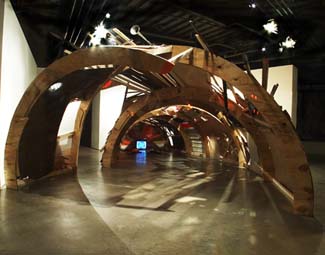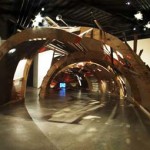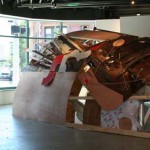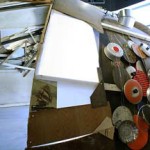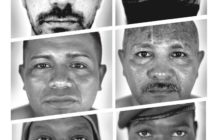By JACQUELINE HOUTON
Artists have long turned to travel as a wellspring for inspiration—Van Gogh had the amber light of Arles, Gauguin the women (and girls) of Tahiti. In Fusiform, the latest exhibition at the Rhys Gallery, Chicago-based artists Juan Angel Chavez, Michael Genovese, and Cody Hudson embrace Boston’s rubbish as their muse.
The visiting artists—all known for creating street art in their native Chicago—have scoured the South End of our coastal city and transformed its trash into “Fusiform,” a massive installation modeled after the shape of a blue whale (for those unfamiliar with the term, fusiform is an adjective denoting a rounded shape that tapers at each end). Collectively envisioned by all three artists, the exhibit’s titular centerpiece was actually assembled by just Genovese and Hudson, who worked on it nearly nonstop for ten days in June. The manmade materials they collected give rise to an organic new whole: battered sheets of scrap metal, shards of frosted glass, jagged triangles of plywood and signage, and other manufactured linear forms coalesce into the cambering curves of the beached creature. The site-specific sculpture dominates the exhibition space, its tail flopping into the gallery’s foyer, a fin submerging on one side of the south wall and resurfacing on the other.
Fusiform is a dynamic structure that forces you to interact with it—to sidle along a wall as you its examine its motley skin, to crouch to inspect the found objects lodged inside its ribcage, to stand up on tiptoe to peer through its blowhole—and every shift in perspective reveals something new. Wanting their work to reflect the local flavor, the artists incorporated nods to our seafaring heritage (well-weathered rope, driftwood, fragments of model ships) and to our urbanity (orange traffic cones, splashes of neon spray paint, news clippings that evoke the gangland history that both Beantown and Chi-town share). And though the SoWa district has been well-gentrified, the visitors still saw vestiges of the neighborhood’s grittier past during their stay, and their brief brushes with homeless people and prostitutes also found their way into the work: the whale’s tail resembles a makeshift shelter, complete with a tin pan of change and a couple of crumpled dollar bills, and the graffiti-inspired window installation that reads “Der She Blows” brings to mind more than the maritime theme.
•
In addition to Fusiform, the exhibit features two smaller collaborative works as well as several individual offerings from each of the three artists. It is a remarkably cohesive collection: Chavez, Genovese, and Hudson each have their own unique style and perspective, but the works all speak to one another through an idiom of reappearing tropes and a shared preoccupation with the interplay between line and curve, rawness and refinement, the manmade and the natural. The three mixed media assemblages that form Cody Hudson’sTowers of Dub series, for instance, recall the fusiform shape and rough materials of the centerpiece: ovoids of unfinished wood—each with two curved sides and two cut straight across—are screwed together into a seven-foot-long line that nonetheless manages to be reminiscent of the rounded, segmented body of a caterpillar. Some wood segments are left bare, calling attention to their natural grain and surface scratches, while others are painted neon orange and shocking pink—colors that also play a role in Fusiform. The flashy palette continues in two acrylic and ink works on wood panels, a duo dominated by lime green and garish orange that is ominously titled I will be there when you die. Crowded with balloon-like ovules that somehow seem to be moving out and apart from one another while remaining tethered together by a complex webbing of lines, the paintings have a feeling of barely-controlled frenzy—like the mood of raucous party moments before a punch is thrown or a kiss is stolen.
Even more intricate examples of line work are found in Michael Genovese’s two aluminum engravings, where the chaos is at once more complex and more elegantly controlled. These arresting works are overwhelming in their intricacy: images emerge and recede from the two beautiful imbroglios composed of carefully etched lines, some razor straight and others like roiling waves. While some of the forms are clearly identifiable—an umbrella, a cask of wine, the spine of a book, an evocative phrase (“the feeling of an outsider lost within the gates”)—others remain tantalizingly ambiguous, things seen only in dreams. The lack of color variation allows the eye to revel in form and visual texture, an approach that Genovese also employs in the graffiti-inspired Gangdom, a large black-on-black painting of enamel on aluminum. The enamel gleams as though still wet, drips dropping straight as plumb lines from Genovese’s curving strokes, in a work that shows how a street ethos can be the source of something surprisingly stately.
While Hudson’s I will be there when you die paintings fill up their entire panels and Genovese’s densely detailed engravings dazzle the eye, Juan Angel Chavez’s studies in line and curve are more delicately restrained. His two untitled drawings in rich crimson ink take up only about a third of their creamy paper canvases, but offer surreal and suggestive scenes that resonate despite their more subdued scale. One has angular forms that look like telephones polls, ladders, and flagstaffs being overtaken by organic elements, like tree branches and solid masses vaguely reminiscent of hands, hearts, and kidneys. The other drawing shows swarms of crosses soaring with sinuous hearts and plumes; near the bottom of the page lie a pile of crosses who never made it airborne, along with one wing, severed from its owner.
These works and others found in Fusiform add up to an engaging display of urban modernism, a visually rich exhibit that is diverse yet harmonious. Transforming the street into the sublime, Chavez, Genovese, and Hudson take the stuff of everyday life—even the disregarded debris of that life—as the material for their art, and their visit has made a refreshing addition to Boston’s summer art scene.
- Interior shots of Fusiform, a site specific installation by Chicago based artists Juan Angel Chavez, Michael Genovese, and Cody Hudson.
“Fusiform” is on view July 26, 2007 at the Rhys Gallery
All images are courtesy of the artists and the Rhys Gallery

